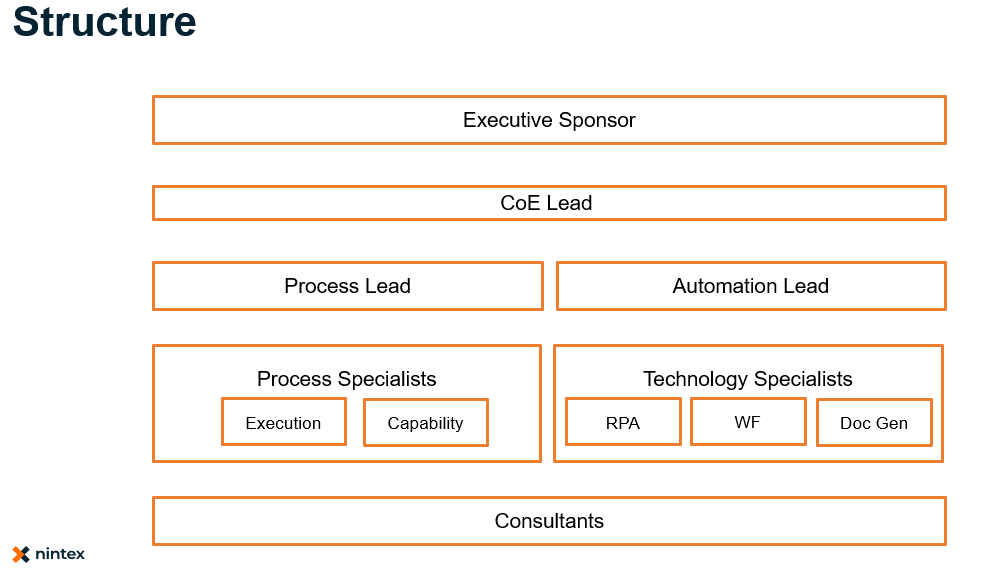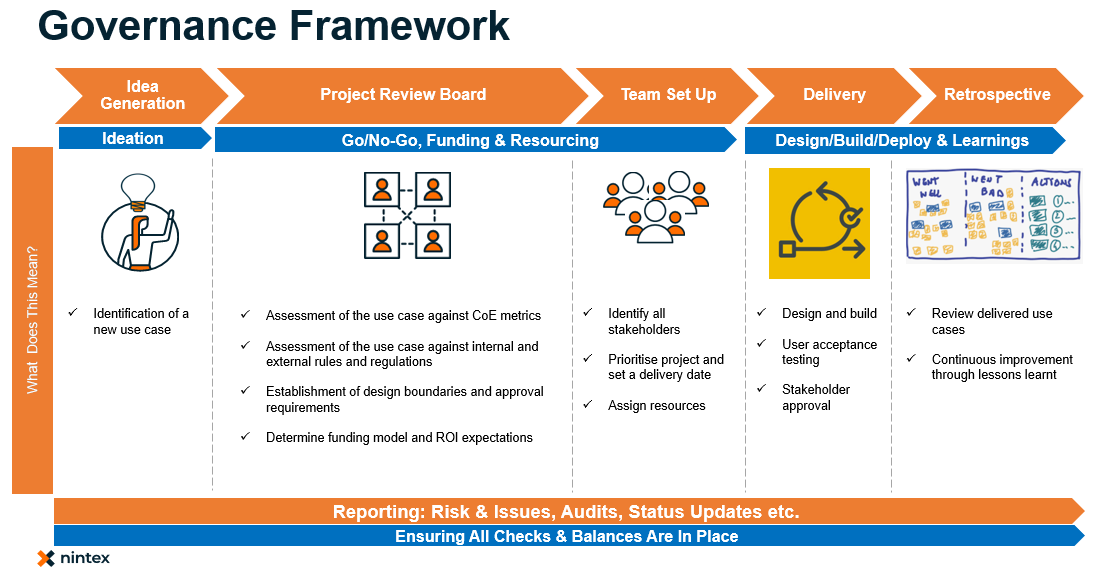In our last post Defining the Roles and Responsibilities of Process Management we discussed the activities that you need to consider ensuring success:
- Creating and enforcing a Process Management Framework
- Process group design
- Process ownership
- Process creation, maintenance, and improvement
The question we want to answer is, does this methodology apply only to Process Management or can we extrapolate this to Process Automation.
I found this Customer comment one of the most impactful as I began my journey into Process Automation,
"We automated a poor process and now we do more, wrong, faster!"
How does a team, group, business unit or organization reduce the risk of doing more, wrong, faster? One way to solve (rather than create) problems through automation is by establishing a Center of Excellence’
The Automation Center of Excellence
As you move through your digital transformation the human component of the CoE will be the foundation from which you will develop from. It is essential to align the right people, skills and vision to the appropriate process. This alignment ensures that all aspects of the automation will be beneficial to the individuals and organizations that are implementing it. The Automation Center of Excellence looks at the big picture of automation transformation. The Center of Excellence treats enterprise automation as a continuous state of change requiring intelligent planning, testing and regular evaluation.
During a recent Regional User Group, the discussion of the Automation Lead culminated in some great insights and benefits of the role including, having the ability to work across all regions and departments, being in an unique position to transparently collaborate with department end-users, and with the ability to cross these boundaries helps: Identify common problems, foster synergy through process alignment and prevent duplication. The Governance Framework helps guide the Center of Excellence as it prioritizes workflow automation projects from Ideation through Retrospective. The Center of Excellence Lead and Workflow Lead assess projects based on the fundamentals set out in the Governance Framework.
Creating and enforcing an Automation Workflow Management Framework
Creating an Automation Workflow Management Framework involves defining the rules that determine how the workflow will be used and managed in your organization. As with the example from our Regional User Group understanding the requirements, the dependencies, the risks and the gaps is a primary function of the CoE Lead and Automation Lead. What other roles are essential in creating and sustaining an Automation Center of Excellence?

The CoE Lead
At the heart of the CoE is the CoE Lead who is responsible for developing the CoE strategy and execution plan. One of the early decisions is to decide the best approach for the CoE to take, whether that is a Centralized, Decentralized or Hybrid. The CoE Lead builds the roll out plan such that there is alignment with the Operational Excellence (OPEX) roadmap created by the Executive Sponsor. By identifying specific KPIs (such as processes mapped, process hits, bots deployed, number of times a WF is run) they will be able to ensure the CoE is on track to achieve its overarching ROI goals/ vision.
One output that the CoE Lead creates is the governance framework. The Framework is a living entity that works from Ideation, project review, team set up, delivery and retrospective. Each engagement will be based on the fundamentals set out in the Governance Framework. For consistent and predictable results each use case can be prioritized using the Framework to identify and resource automation projects that meet specific KPIs. Included in the Governance Framework the CoE Lead will formulate the required checks and balances for an idea to be created and deployed and the minimum standards for acceptability.

The CoE Lead will own the communication plan. Overall responsibility for creating the overarching communication plan to tell the organization the purpose of the CoE, how to identify use cases, how to engage, sharing success stories etc. This will then require other people (e.g the Exec Sponsor) to execute.
The Automation Lead
Where requests for technology solutions come in, the Automation lead will determine go/ no go and will prioritize their delivery. They will then triage the development to the technology specialists. The Automation Lead is also responsible for defining the Technology Roles and Responsibilities for each Automation Project.
Technology Specialists
Automation projects don’t have to be spearheaded by the IT department, but IT should be involved from the start. For a successful automation project, you’ll need a core group with a variety of diverse skills. Within the category of Technology, you can further break it down into specific skillsets. The below are useful examples:
The Business Analyst
The business analyst has a talent for visualizing areas keen for improvement. A quality business analyst will see and document a process as they are in their current state then redesign them to meet future requirements providing enough detail that a developer can easily build the workflow. While an acumen for Process Optimization is helpful the ability to have meaningful discussions with process stakeholders and end users is equally as valuable.
The Technology Specialists
This role revolves around taking well-documented processes from the business analyst and creating automated tasks and workflows. The beauty of using a low code/no code Workflow Automation solution means that the technology specialists do not have to be an actual programmer—they can be anyone with the ability to build effective workflows. Some automation teams have multiple levels of developers.
The Catalyst for true change
Opportunities for automation come from every angle, whether it is a front line manager interested in saving time on manual processes, an individual contributor who may have already been automating tasks on their own, or a senior executive with aspirations of making the enterprise more productive, your automation project probably started with people enthusiastic about the benefits of automation. After the initial surge designing and deploying a few automation solutions, many businesses struggle with next steps. What often happens is that the automation solution with the power to transform whole enterprises is left to manage some rudimentary workflow processes. Teams wonder how they could save time processing paperwork but have no idea that they could be using the solution that another department has already implemented.
To move the digital transformation forward we need to enlist at least one more important ally.
The Executive Sponsor
Getting executive sponsorship and visibility is key. An executive sponsor could be any of the C-Suite but the preferable one is the CEO. In most cases employees recognize the CEO before they do any other C-Level individual because they are the face and voice of the Organization. They will be someone committed to maximizing ROI for your organization, and they will see how the long-term savings from automation fit into the big picture of the organization’s finances. Ideally this person could end up sitting on the steering committee.
Using Low Code/ No Code technology it is becoming easier and easier to automate processes, however it is important to remember that just because a process can be automated, doesn’t mean that it should be automated. By establishing and correctly structuring a CoE to take responsibility of delivering automation to your business you will not only ensure that your automation initiatives are delivered efficiently and to an appropriate standard, but also that the initiatives that are delivered have a meaningful impact.

